Llanegryn is a village situated within the Snowdonia National Park, in the historic county of Merionethshire. The village is about four miles north-east of Tywyn and seventeen miles south-west of Dolgellau. The men of the village who fell in the Great War are commemorated on the Parish War Memorial, which is situated in front of the Parish Church, in the form of a Celtic Cross. The names are in order of date died on the memorial, but I have listed them alphabetically below, for ease of reading.
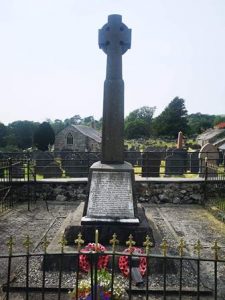
The Great War, 1914-1918
William Davies, Private, 61189, Royal Welsh Fusiliers. William was the son of David and Sarah Davies, of Rhos, Llanegryn. He enlisted at Towyn into the army and was posted to France in 1917, joining the 2nd Battalion, Royal Welsh Fusiliers. The 2nd RWF was by then attached to 19 Brigade, 33rd Division and saw heavy fighting at the Third Battle of Ypres, especially during its assault on Polygon Wood. On 6 February 1918 the 2nd RWF was transferred to 115 Brigade, 38th (Welsh) Division, at Armentieres. The Division moved south to the Somme sector at the end of March 1918, taking up the line north of Albert, facing Aveluy and Thiepval Woods. The Division held the line here over the coming months, taking part in minor actions at Bouzincourt Ridge and Aveluy Wood, before launching their assault over the River Ancre on 21 August 1918, beginning the great offensive which would ultimately win the war. Over the coming weeks the Division pushed forward past the old Somme battlefields of 1916 towards the and by the beginning of October had reached Sorel-le-Grand, within touching distance of the Canal du Nord, and then Hindenburg Line. On 8 October the Hindenburg Line was breached, and the Division then began to advance towards the River Selle. On 18 October 1918 the Division was near Le Cateau, having crossed the Selle, and the 2nd RWF was in the proceeds of being relieved when William was killed. The 35-year-old is buried in St. Souplet British Cemetery, France.
Evan Ellis, Private, 1129, Welsh Guards. Evan was the son of Evan and Margaret Ellis, of Ismael, Llanegryn. He married Priscilla Jones in 1906 prior to becoming a Policeman at Bute Docks, Cardiff. He enlisted at Cardiff into the 1st Battalion, Welsh Guards. The Regiment was raised by Royal Warrant of 26 February 1915, at White City, before landing at Le Havre on 18 August 1915, becoming attached to 3rd Guards Brigade, Guards Division. The Division saw its first major action during the Battle of Loos, which began on 25 September 1915, remaining in the area during the coming months, where they also fought in the subsequent Action of Hohenzollern Redoubt. On 14 December 1915 the Welsh Guards were in the line at Winchester House, when Evan was killed by machine-gun fire. The 33-year-old has no known grave and is commemorated on the Loos Memorial, France.
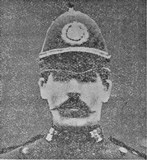
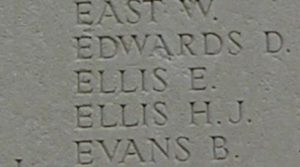
Griffith Evans, Private, 290588, Royal Welsh Fusiliers. Griffith was the son of Thomas and Jane Evans, of Llwyn, Llanegryn. He worked as a farm hand prior to enlisting at Towyn into the Royal Welsh Fusiliers on 15 August 1914. He was initially posted to the 2/7th Battalion, Royal Welsh Fusiliers, which was attached to the 68th (Welsh) Division at Northampton, then Bedford. On 19 January 1916 he was posted to Egypt, joining the 1/7th Battalion, Royal Welsh Fusiliers, which was attached to 158 Brigade, 53rd (Welsh) Division. The Division, as part of the EEF, helped guard the Suez Canal in 1916, and played a part in defeating the Senussi tribesmen that year, before advancing across the Suez Canal, in readiness to take part in the offensive into Palestine. The Division moved into Palestine in March 1917, where they remained for the duration of the war, fighting at the Battles of Gaza, and successfully capturing Jerusalem. Attention then turned to the Jordan Valley and Jericho, so the EEF continued its advance north. Griffith was killed on 22 February 1918, during the fighting to take Jericho. He was 24 years old and is buried in Jerusalem War Cemetery, Israel.
Owen Humphreys, Private, 10019, King’s Shropshire Light Infantry. Owen was born at Llanegryn, the son of David and Mary Ann Humphreys. After his father’s death in 1905, the Owen moved to Furnace Cottage, Eglwysfach to live with his Aunt, Annie Hughes. He worked as a collier at Treharris prior to enlisting into the 1st Battalion, King’s Shropshire Light Infantry, and landed with the battalion in France on 10 September 1914, where it was attached to 16 Brigade, 6th Division. Owen was wounded at some time, and after recovering was posted to the 2nd Battalion, KSLI, sending home a series of vivid letters, detailing his experiences at war. By the beginning of 1918 he had been wounded four times, and returned home on leave to recuperate. On 15 June 1918 Owen was joined by a friend from the 2nd KSLI who was also on leave, and the pair borrowed two bicycles to ride into Aberystwyth. Owen crashed his cycle on a bend at Llanbadarn, and sustained injuries which caused him to die in hospital later that day. He was 22 years old, and was buried with full military honours in Eglwysfach (St. Michael) Churchyard. Owen is not commemorated at Llanegryn.
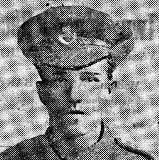
Ebenezer Davies Jones, Pioneer, 240201, Royal Engineers. Ebenezer was the son of Abram and Martha Jones, of Llanegryn. He married Rosetta Johanna Berry on 29 September 1906, and the couple set up home at Butcher Row, Llanegryn. Ebenezer worked as a labourer and lived at The College, Llwyngwril prior to enlisting into the Royal Engineers on 13 February 1917, and was posted to France on 12 March 1917, joining the 335th Road Construction Company, RE. He was not in France long before his health broke down and he contracted pneumonia. Ebenezer was sent home aboard the Hospital Ship Gloucester Castle, but sadly deteriorated and died of heart failure following pneumonia whilst still at sea, in the English Channel, on 30 March 1917, aged 45. A post mortem was carried out at the 5th Southern General Hospital, Portsmouth, and he was buried in Milton Cemetery, but his remains were later exhumed and conveyed home for burial in St. Celynin Churchyard, Llwyngwril.
Griffith Jones, Private, 2525, Royal Welsh Fusiliers. Griffith was the son of David and Ann Jones, of 2, Egryn Terrace, Llanegryn. He enlisted at Llwyngwril into the 1/7th Battalion, Royal Welsh Fusiliers. The battalion mobilised at Newtown following the declaration of war, as part of North Wales Brigade, Welsh Division. The Division moved to Northampton then Bedford where it became re-numbered to 158 Brigade, 53rd (Welsh) Division and embarked from Devonport in July 1915 for the Mediterranean, landing at Suvla Bay, Gallipoli on 9 August 1915. The Division advanced inland, but had no idea of the terrain and very few maps, so many of the battalions became disorientated, and over the next few days took part in chaotic fighting. Griffith was killed in action on the following day, 10 August 1915, aged 22. He has no known grave and is commemorated on the Helles Memorial, Gallipoli.
John Evan Jones, Private, 38504, Gloucester Regiment. John was born at Llanegryn in 1899, the son of Joseph and Jane Jones. John was raised by Mr William Lloyd, at Aberystwyth Poor Law Institution. He enlisted at Wrexham into the South Wales Borderers, and was posted to France at sometime after 1917, joining the 8th Battalion, Gloucestershire Regiment, which was attached to 57 Brigade, 19th (Western) Division. John probably joined the battalion after its exertions at Messines in 1917. The Division then fought on the Menin Road and at Polygon Wood, before moving up to Broodseinde, Poelcappelle and Passchendaele Village itself. In 1918 the Division was caught up in the German Spring Offensive near St. Quentin, where they suffered terrible casualties, taking part in a gallant rearguard action around Bapaume, before moving to Ypres to rebuild. Unfortunately the next phase of the German plan was a strike at Messines, to force a passage to the channel ports. John was killed during the German attack at Messines on 9 April 1918. He was 18 years old, and is commemorated on the Tyne Cot Memorial, Belgium. He is not commemorated at Llanegryn, but at Aberystwyth.
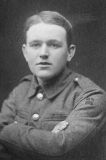
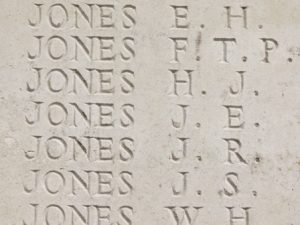
Ellis Lewis, Private, DM2/165937, Royal Army Service Corps. Ellis was the son of Ellis and Anne Lewis, of Trychiad, Llanegryn. By 1911 he was living with his brother, Richard, and their widowed mother Anne at 5, The Avenue, Pontypridd, where the brothers had found work. Ellis worked as a carpenter prior to enlisting at Pontypridd into the Army Service Corps, and embarked for France at some time after 1916 with the Mechanical Transport, Army Service Corps. Ellis served in France for the remainder of his time at war, but became ill and died of influenza on 5 November 1918, aged 34, less than a week before the Armistice. He is buried in Pont-De-Nieppe Communal Cemetery, France.
William Lloyd, Private, 26799, South Wales Borderers. William was the son of John and Elizabeth Lloyd, of Pentra, Llanegryn. He enlisted at Aberystwyth into the South Wales Borderers and was posted to Salonika, joining the 7th Battalion, South Wales Borderers, which was attached to 67 Brigade, 22nd Division. The Division had originally been in France, but on 27 October 1915 embarked at Marseilles for Salonika. It remained in the theatre for the rest of the war, taking part in the Retreat from Serbia during December 1915. Between 10 to 18 August 1916 they fought at the battle of Horseshoe Hill, then between 13 to 14 September 1916 at the battle of Machukovo. Between 24-25 April and 8-9 May 1917 the Division fought at the battle of Doiran, and then there was a lull in the fighting, which remained until the final offensives of September 1918. William unfortunately lost his life during this quieter period at Salonika, dying of wounds on 12 May 1918, aged 33. He is buried in Salonika (Lembet Road) Military Cemetery, Greece. Probate was granted to two women: Annie Thomas, of Harlech, who was raising one illegitimate child of his; and Ellen Edwards, of Llanegryn, who was raising illegitimate twins of his.
John Morgans, Private, 36247, Royal Welsh Fusiliers. John was the son of Isaac and Elizabeth Morgans, of Egryn Cottage, Llanegryn. He enlisted into the Royal Welsh Fusiliers on 11 October 1915 and after completing his training was posted to France, joining the 13th Battalion, Royal Welsh Fusiliers, which was attached to the 38th (Welsh) Division. He would have joined the battalion after the Division was evacuated from the Somme in 1916, following its efforts in capturing Mametz Wood, and served with the Division during its assault on Pilckem Ridge from 31 July 1917. At some time afterwards he was posted to the 1st Battalion, Royal Welsh Fusiliers, but his health had begun to deteriorate. John was discharged from the army as medically unfit on 24 July 1919 and returned home to Wales, but died of pulmonary tuberculosis at Holyhead on 9 May 1920, aged 22. His remains were brought home for burial in St. Egryn’s Churchyard, Llanegryn.
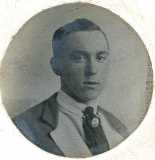
Walter Edward Pugh, Private, 277437, Manchester Regiment. Walter was born at Wallingford, Berkshire in 1898, the son of George and Sarah Pugh. The family later moved to Penmaenmawr by 1911 and then to The Cottage, Pemarthuchaf, Towyn. Walter enlisted into the Royal Welsh Fusiliers, but upon completing his training, was posted to the 2/7th Battalion, Manchester Regiment, which was attached to 199 Brigade, 66th Division. He landed in Boulogne, France with the battalion on 7 March 1917, and the entire Division then concentrated around the area of Aire-sur-la-Lys, before heading to Cambrin. On 19 March 1917 Walter’s battalion moved into the front line for the first time, taking over a section of line on the left of the Cambrin sector. On 21 March 1917, on his third day in the trenches, Walter was killed when a German trench mortar shell hit a dugout he was sharing with some other men. He was 19 years old and is buried in Dud Corner Cemetery, Loos, France.
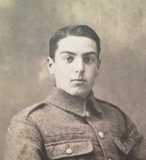
John Rees, Corporal, 11454, Grenadier Guards. John was the son of David and Ann Rees, of Reform Cottage, Bryncrug, Tywyn. He had served during the Boer War of 1899-1902 prior to moving to Llandybie to work for the Post Office as a letter carrier. John re-enlisted at Aberystwyth soon after the outbreak of war into the 2nd Battalion, Grenadier Guards. He joined the battalion in France on 30 September 1914. The battalion was attached to the 4th (Guards) Brigade, 2nd Division, and had been among the first units in France, fighting at the Battle of Mons, and retreating southwards, where the Division took part in the Affair of Landrecies, the Rearguard Actions of Villers-Cotterets, and at the Battle of the Marne where the German offensive was stopped. The BEF then moved north to guard the Channel ports, and took up defensive positions east of Ypres. The 2nd Division then fought at the First Battle of Ypres, where the German sweep through Flanders was stopped, and remained there throughout the first winter of the war. The conditions were terrible, and John was hospitalised in February 1915 after falling ill. Upon his recovery, he was posted to the 1st Battalion, Grenadier Guards on 7 March 1915. The battalion was at Neuve Chapelle, attached to 20 Brigade, 7th Division, and was preparing for an offensive. On 10 March 1915 the 1st Grenadiers took part in the Battle of Neuve Chapelle, which had been launched in conjunction with a French assault on Vimy Ridge. The battle proved a disaster for the Allies, with no real gains, despite suffering heavy casualties. John was killed in action at sometime between 10 to 14 March 1915. The 32-year-old has no known grave and is commemorated on the Le Touret Memorial, Richebourg L’Avoue, France. He is also commemorated on the Tywyn and the Llandybie memorials.
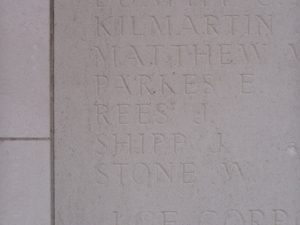
John Rees, Private, 204750, Royal Welsh Fusiliers. John was the son of David and Mary Rees, of Trychiad, Llanegryn. He enlisted at Dolgellau into the 4th Battalion, Royal Welsh Fusiliers, and after completing his training had a spell of leave, visiting his parents in May 1917, before being posted to France, joining the 14th Battalion, Royal Welsh Fusiliers, which was attached to 113 Brigade, 38th (Welsh) Division. He saw his first action during the Divisions assault on the Pilckem Ridge on 31 July 1917, the opening day of the Third Battle of Ypres. Following the ensuing Battle of Langemarck, the entire Division was moved to positions near Armentieres over the winter. After the Germans launched their offensive on the Somme on 21 March 1918, the Division was moved back to the Somme, and took up positions north of Albert, around Aveluy Wood. On 21 April 1918 the 13th RWF moved into the front line facing Bouzincourt Ridge, relieving the 2nd RWF and at 07.30 the following morning 113 Brigade assaulted the Bouzincourt Ridge, with the aim of taking the high ground from the Germans. Heavy casualties were suffered during the day, with the 13th RWF alone suffering almost 270 casualties. John had been wounded during the attack and was evacuated to the 3rd Canadian Stationary Hospital at Doullens, where he died of his wounds on 24 April 1918, aged 20. He is buried in Doullens Communal Cemetery Extension No. 1, France.
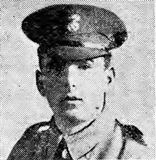
Edward Llewellyn Richards, Lance Corporal, 2042, Royal Welsh Fusiliers. Edward was the son of Cadwaladr and Gwen Richards, of Bodowen, Llanegryn. He had served for three years with the 5th Volunteer Company, South Wales Borderers prior to the war and re-enlisted at Towyn into the 1/7th Battalion, Royal Welsh Fusiliers. The battalion mobilised at Newtown following the declaration of war, as part of North Wales Brigade, Welsh Division. The Division moved to Northampton then Bedford where it became re-numbered to 158 Brigade, 53rd (Welsh) Division and embarked from Devonport in July 1915 for the Mediterranean, landing at Suvla Bay, Gallipoli on 9 August 1915. The Division advanced inland, but had no idea of the terrain and very few maps, so many of the battalions became disorientated, and over the next few days took part in chaotic fighting. Edward was killed in action four days later, on 13 August 1915, aged 40. He has no known grave and is commemorated on the Helles Memorial, Gallipoli.
Evan Richards, MSM, Driver, T3/024898. Evan was born in Llanegryn in 1893. He worked as a carter at Gwyddffryniau prior to enlisting into the Army Service Corps at the outbreak of war. He married Edith Lucy Bailey, of Grove Cottage, Chalfont St. Giles, Bucks whilst training in the area. He was posted to the 1st Company, 35th Divisional Train, Army Service Corps. The Division moved to France in late January and early February 1916 and saw its first major action during the Battle of the Somme. The Division was found to be somewhat wanting and was rebuilt with men from disbanded yeomanry regiments, before going back into the line early in 1917 and following the German Retreat to the Hindenburg Line. Later in the year the Division moved north to Ypres, and fought at the Second Battle of Passchendaele. By Spring of 1918 it was back on the Somme, and fought during the German Offensive. It was then moved back north, and fought later in the year during the great advance in Flanders, reaching the line of the River Dendre when the armistice halted the fighting at 11.00 on 11 November 1918. Evan was still in France when he sadly drowned during a bathing accident on 4 January 1919, aged 27. He is buried in Bleue-Maison Military Cemetery, Eperlecques, France. He was posthumously awarded the Meritorious Service Medal, in the Peace Gazette of 1919. His widow, Edith, died on 5 January 1962, after having never remarried.
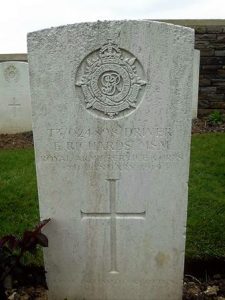
David Griffith Roberts, Private, 43939, South Lancashire Regiment. David was the son of Griffith and Mary Ann Roberts, of Glanrafon, Llanegryn. He had enlisted towards the end of the war and was initially posted to the 14th Battalion, South Lancashire Regiment. He must have been unfit for front line service, as he was posted to the 550th Agricultural Company, Labour Corps. He survived the war, but became ill after the Armistice and died at home in Llanegryn on 7 January 1919, aged 19. David is buried in St. Egryn’s Churchyard, Llanegryn.